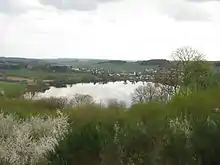Eifel hotspot

The Eifel hotspot is a volcanic hotspot in Western Germany. It is one of many recent volcanic formations in and around the Eifel mountain range and includes the volcanic field known as Volcanic Eifel. Although the last eruption occurred around 10,000 years ago, the presence of escaping volcanic gases in the region indicates that it is still weakly active.
There are two competing theories concerning the origin of volcanic activity in the area. The conventional view is that the province is underlain by a mantle plume.[2][3] Support for a plume origin includes petrological, geochemical, and isotopic evidence indicating a deep-mantle source,[4][3] seismic anomalies in the upper and lower mantle,[5][6][7][8] and geodetic evidence of large-scale uplift and extension which suggests a buoyant plume.[9]
Recently, some scientists have highlighted that certain characteristics associated with mantle plumes such as precursory uplift, time-progressive volcanism, and continuity between seismic anomalies in the upper and lower mantle are lacking. They have thus argued instead for a tectonic origin consisting of passive melting due to lithospheric and crustal extension and shallow convective processes involving the ongoing subduction of the Eurasian Plate as part of the Alpine orogeny.[10][11][12]
See also
References
- "Schalkenmehrener Maar" (in German). Natur- und Geopark Vulkaneifel GmbH. 2021. Retrieved 31 December 2022.
- Ritter, J.R.R.; Jordan, M.; Christensen, U.R.; Achauer, U. (2001). "A mantle plume below the Eifel volcanic fields, Germany". Earth and Planetary Science Letters. 186 (1): 7–14. doi:10.1016/S0012-821X(01)00226-6.
- Schmincke, H.U. (2007). "The Quaternary Volcanic Fields of the East and West Eifel (Germany)". In Ritter, J.R.R.; Christensen, U.R. (eds.). Mantle plumes – A multidisciplinary approach. Springer. pp. 241–322. doi:10.1007/978-3-540-68046-8_8. ISBN 978-3-540-68045-1.
- Wedepohl, K.H.; Baumann, A. (1999). "Central European Cenozoic plume volcanism with OIB characteristics and indications of a lower mantle source". Contributions to Mineralogy and Petrology. 136 (3): 225–239. doi:10.1007/s004100050534. S2CID 128608750.
- Walker, K.T.; Bokelmann, G.H.R.; Klemperer, S.L.; Bock, G. (2005). "Shear-wave splitting around the Eifel hotspot: Evidence for a mantle upwelling". Geophysical Journal International. 163 (3): 962–980. doi:10.1111/j.1365-246X.2005.02636.x.
- Pilidoua, S.; Priestley, K.; Debayle, E.; Gudmundsson, O. (2005). "Rayleigh wave tomography in the North Atlantic: High resolution images of the Iceland, Azores and Eifel mantle plumes". Lithos. 79 (3–4): 453–474. doi:10.1016/j.lithos.2004.09.012.
- Ritter, J.R.R. (2007). "The seismic signature of the Eifel plume". In Ritter, J.R.R.; Christensen, U.R. (eds.). Mantle plumes – A multidisciplinary approach. Springer. pp. 379–404. doi:10.1007/978-3-540-68046-8_12. ISBN 978-3-540-68045-1.
- Zhao, D. (2007). "Seismic images under 60 hotspots: Search for mantle plumes". Gondwana Research. 12 (4): 335–355. Bibcode:2007GondR..12..335Z. doi:10.1016/j.gr.2007.03.001.
- Corné Kreemer; Geoffrey Blewitt; Paul M. Davis. (2020). "Geodetic evidence for a buoyant mantle plume beneath the Eifel volcanic area, NW Europe". Geophysical Journal International. 222 (2): 1316–1332. doi:10.1093/gji/ggaa227.
- Regenauer-Lieb, K. (1998). "Dilatant plasticity applied to Alpine collision: Ductile void growth in the intraplate area beneath the Eifel volcanic field". Journal of Geodynamics. 27 (1): 1–21. doi:10.1016/S0264-3707(97)00024-0.
- King, S.D. (2007). "Hotspots and edge-driven convection". Geology. 35 (3): 223–226. doi:10.1130/G23291A.1.
- Lustrino, M.; Carminati, E. (2007). "Phantom plumes in Europe and the circum-Mediterranean region". In Foulger, G.R.; Jurdy, D.M. (eds.). Plates, plumes, and planetary processes: Geological Society of America Special Paper 430. Geological Society of America. pp. 723–745. doi:10.1130/2007.2430(33). ISBN 9780813724300.
